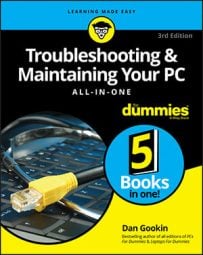Troubleshooting & Maintaining Your PC All-in-One For Dummies, 3rd Edition
Explore Book Buy On Amazon- A recovery volume: Use this media to start the PC and access the Windows Recovery Environment. The tools presented help you navigate through recovery.
- The system image: Use this information to restore Windows and other partitions as a base to rebuild your computer system. Tools on the recovery volume help you use the system image information.
- File History: Finally, with Windows restored, you run the File History program to recover your PC's lost files and programs.
- Start the PC by using the Windows Recovery Environment.
- Choose Troubleshoot.
- Choose Advanced Options.
- Choose System Image Recovery.
Yes, the process is more complex than four simple steps. For example, you may need a replacement hard drive. The good news is that you have the system image if you need it. Along with a recent backup, you can fully restore your system no matter what happens to the computer.

